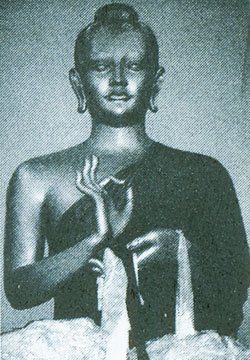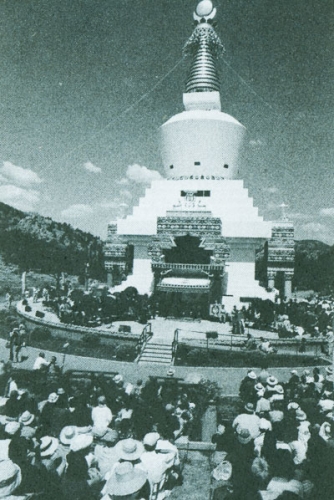
It’s highway driving for the first two hours north of Denver. After Fort Collins, taking the left fork at a gas station known only as Ted’s Place, we head steadily uphill through the towering crags of the Rockies. Beyond the last town, at eight thousand feet, we turn right onto an all-dirt road. Valleys filled with sage and wild horses greet us, tucked amid mountains that soar. It’s highway driving for the first two hours north of Denver. After Fort Collins, taking the left fork at a gas station known only as Ted’s Place, we head steadily uphill through the towering crags of the Rockies. Beyond the last town, at eight thousand feet, we turn right onto an all-dirt road. Valleys filled with sage and wild horses greet us, tucked amid mountains that soar.
Brilliantly colored banners mark the dirt entry to the 552-acre Rocky Mountain Shambhala Center (RMSC), founded in the early 1970s by the late Vidyadhara, the Venerable Chogyam Trungpa Rinpoche. The banners announce the consecration of the Great Stupa of Dharmakaya Which Liberates Upon Seeing. Along with a thousand others, including more than fifty high-ranking lamas and monks, I’ve arrived for an eleven-day meditation retreat that will help prepare the way for the stupa’s consecration on August 18. On that day, fifteen hundred more people will arrive.
Trungpa Rinpoche was the first to bring Tibetan Buddhist teachings in English to large numbers of Western students. The eleventh incarnation of Trungpa tulkus—each one Supreme Abbot of the Surmang monasteries in eastern Tibet—Trungpa Rinpoche fled Tibet in 1959. He came to the United States in 1970. Before he died in 1987 at the age of 47, he had written fourteen books (some still Buddhist bestsellers); established Naropa University, an accredited liberal arts college in Boulder, Colorado; founded four major retreat centers; trained students in a range of contemplative arts from ikebana (Japanese flower arranging) to English dressage; and created a sometimes controversial community filled with poetry and music, and a vision of an enlightened world. In order to accomplish all this, Rinpoche launched an organization, now called Shambhala International, with 150 centers worldwide.
The Sanskrit word stupa, which literally means “a heap,” a mound of dirt, has come to mean a sacred Buddhist monument containing the relics of the Buddha or other holy figures. As the Buddha was dying, it is said, he told his bereaved followers they should build a stupa so that those who saw it would awaken to his teachings as if it were him they were seeing. His disciples divided his remains and went on to build eight stupas, each marking a place crucial to the Buddha’s life and enlightenment.
Centuries later, parts of the Buddha’s remains were removed, and thousands of additional stupas were constructed, each becoming a site for religious pilgrimage. Other stupas were built for great subsequent teachers, as just seeing one, it is said, arouses the mind of enlightenment in the viewer.

After he died, Trungpa Rinpoche’s own bereaved students asked His Holiness Dilgo Khyentse Rinpoche what they should do. He told them to build a stupa, a subject about which, let’s say, they were clueless. It turned out that His Holiness the Sixteenth Gyalwang Karmapa had already picked a spot, and Khyentse Rinpoche confirmed it. Under the guidance of the Venerable Benchen Tenga Rinpoche, also from Surmang and one of the world’s leading experts on Tibetan art and the construction of stupas, volunteers gathered —carpenters, architects, artists. They decided to combine classic Buddhist iconography with twenty-first-century technology. The price tag: $2.7 million—a bargain, actually, for what it bought.
From the first curve in the dirt driveway, one can see it gleaming against the mountains: a jaw-dropping, 108-foot-high structure said to echo the form of the seated Buddha himself. Hardly a simple dirt mound, this stupa—fourteen years in the making—is composed of a special mix of poured concrete intended to last a thousand years. Painted stark white and trimmed in gold leaf and vivid Tibetan reds, oranges, turquoises, and yellows, the three-story structure is topped with a gold moon and sun disk spire.
Most stupas are solid, but this one houses meditation rooms. On the first floor sits a twenty-foot-high gold Buddha, with Trungpa Rinpoche’s post-cremation skull and part of his spine in its heart center. On higher floors, in Vajrayana practice spaces, are other statues, including the bronze fourteen-foot standing Buddha first unveiled at Tricycle’s “Change Your Mind Day” in New York’s Central Park in June (ironically, three months after the Taliban destroyed the ancient standing Buddhas of Bamiyan in Afghanistan). The statues at RMSC are among the finest examples of Buddhist iconography in the West, and all of them have been made by American practitioners. Embedded throughout the whole structure are the remains of other great Buddhist teachers, as well as thousands of tiny rolled mantras, blessings, and prayers.
Near the stupa, within wide white tents, His Holiness Penor Rinpoche, Dzigar Kongtrul Rinpoche, Dzongsar Khyentse Rinpoche, other lamas, and American practitioners blare horns, ring bells, sound drums, and chant to bring these blessings to life, to make the stupa a lightning rod for enlightened spiritual energy.
Leading the Shambhala community today is Trungpa Rinpoche’s son, the Sakyong Jamgon Mipham Rinpoche. He grew up in the community in Boulder and Halifax, Nova Scotia, and was recognized by Dilgo Khyentse Rinpoche as an incarnation of the great Buddhist teacher Mipham Rinpoche. Born Osel Mukpo, in Bodhgaya, where the Buddha attained enlightenment, he was trained first by his father, then by Khyentse Rinpoche, and enthroned as Sakyong by Penor Rinpoche in 1995.
And on this eighteenth day of August, the Sakyong presides at the consecration of the Great Stupa of Dharmakaya Which Liberates Upon Seeing. In doing so, he serves a community that now includes his peers and their children. In the years that it has taken to build the stupa, Buddhism has become part of the American landscape. Amid the feast practices and the contemplative arts performances, amid the talk and joy and tears, this gathering marks the maturation of Tibetan Buddhism among generations of Americans. ▼
Thank you for subscribing to Tricycle! As a nonprofit, we depend on readers like you to keep Buddhist teachings and practices widely available.